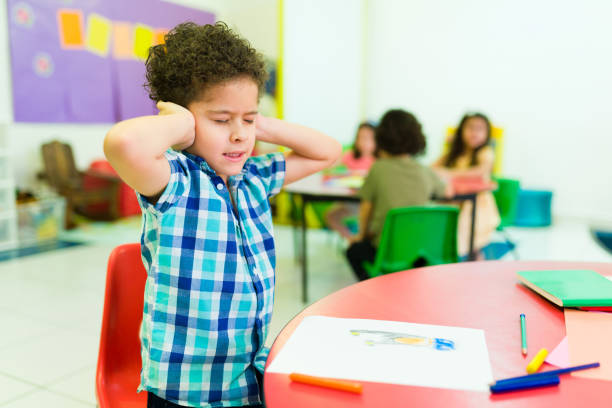Sensory Sensitivities in Children
By Julie McGowan, LMSW
February 2024

Last month you learned about all our senses, including proprioception, vestibular and interoception. This month we will talk about what happens when your child has difficulties processing these senses. When a child’s sensory system is off balance, it can result in sensory input feeling overwhelming or under-stimulating. This can make it difficult to regulate emotions, behave in age-appropriate ways, and complete daily tasks. We will take a look at some of the common sensitivities that children may have and explore how to help support them.
Tactile Sensitivity
What it means: A child with tactile sensitivity may be defensive and uncomfortable with touch, especially light touch, to the skin. Their nervous system may interpret this touch as a sign of danger resulting in a flight or fight type response.
What To Do: Parents and child will need to find alternative ways to connect and safe ways to touch. A tolerance to touch will need to be built up before expecting a child to be able to engage well in touch related activities.
Taste/Smell Sensitivity
What It Means: A child with taste/smell sensitivity will often be a picky eater or challenging at mealtimes. They may engage in power struggles around food. Some children may also be under-sensitive to taste/smell and want to smell everything or seek out strong or spicy flavors.
What To Do: Parents should develop a system that reduces tension around mealtime. It may help to give the child choices between two things to help them feel empowered as well as getting them involved in planning/cooking meals.
When a child’s sensory system is off balance, it can result in sensory input feeling overwhelming or under-stimulating. This can make it difficult to regulate emotions, behave in age-appropriate ways, and complete daily tasks.
Movement Sensitivity
What It Means: A child with movement sensitivity may be uncomfortable with certain movements, particularly movements that are unpredictable such as roughhousing. This sensitivity may cause them to react to movement or the suggestion of movement, such as feet leaving the ground.
What To Do: Activities between parent and child should be structured to the child’s level of tolerance of movement. It can be helpful to provide narrations around what will happen during movements, for example, "I am going to pick you up and put you in your high chair".
Under Responsive/Seeks Sensation
What It Means: A child that has difficulty in this area may be under-responsive or over- responsive, with reactions that are not always consistent and predictable. Children who seek sensation often jump, spin, flip, and crash more than the typical child their age.
What To Do: Parent should build activities into the child’s day that focus on up-regulation or down-regulation according to the child’s needs. They should also find ways to allow big body movements in a safe space such as jumping on a trampoline, climbing up a slide or doing cartwheels.
Auditory Filtering
What It Means: A child with auditory filtering sensitivities may be either sensitive to sounds or seem oblivious to sounds. This may present as a child that appears to not be listening. This child may not be able to separate important stimuli (calling their name) from unimportant stimuli (other noises in the environment). This child may also be easily agitated by sounds that others do not hear such as the humming of lights. This sensitivity may make it difficult for a child to concentrate and complete tasks, particularly in environments that have more stimuli such as classrooms or public spaces.
What To Do: This child will need their environment to be intentionally structured around times that concentration is expected. This may be decreased noise, clutter, and frequent breaks. It will be helpful when trying to gain this child’s attention to be in their field of vision and give a physical cue, such as touching their shoulder, when communicating.
While it is not always easy to recognize when or what sensory sensitivities are at play, it is important to remember that they can have a significant impact on the child’s functioning and behavior and should be considered when managing big emotions or behaviors.
About the Author

Julie McGowan, LMSW
Julie is a Licensed Clinical Social Worker with over 15 years of experience providing services to children and families with histories of trauma, disruptions of attachment, early medical interventions, and foster care/adoption involvement as well as children with anxiety, sensory difficulties, dysregulation, and behaviors. She believes that secure relationship is the key to healing and change and that in order for children to learn how to regulate themselves they need a safe, regulated adult to support them.
